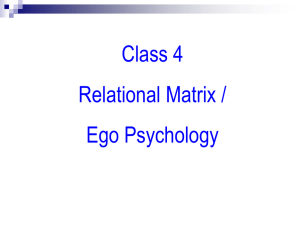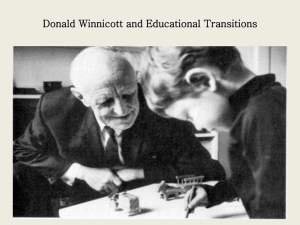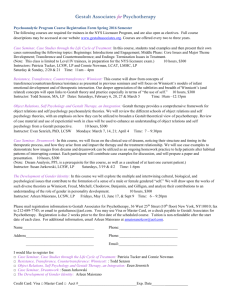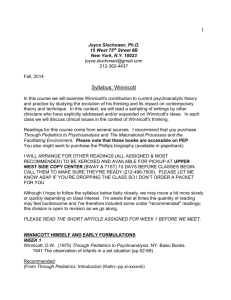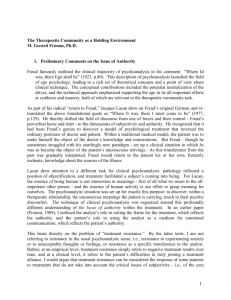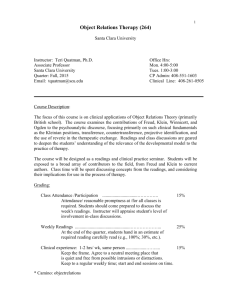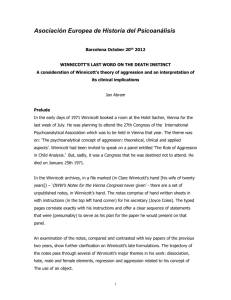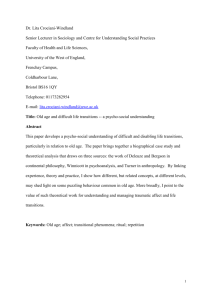Continuous Case Seminar: Problems in Early Integration
advertisement
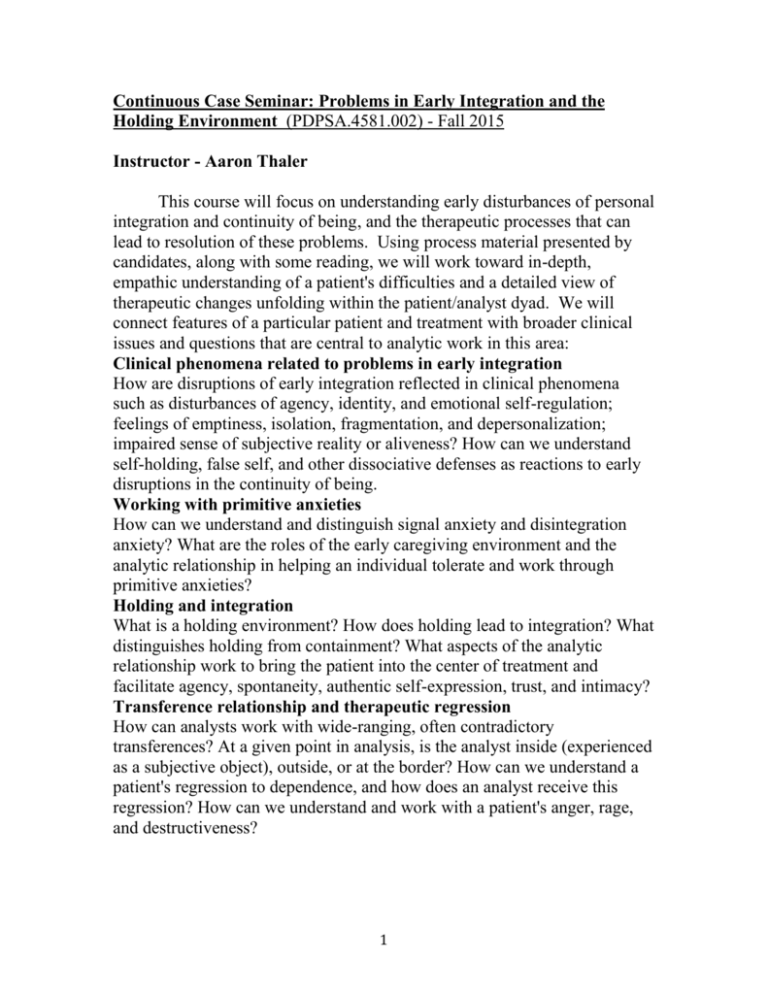
Continuous Case Seminar: Problems in Early Integration and the Holding Environment (PDPSA.4581.002) - Fall 2015 Instructor - Aaron Thaler This course will focus on understanding early disturbances of personal integration and continuity of being, and the therapeutic processes that can lead to resolution of these problems. Using process material presented by candidates, along with some reading, we will work toward in-depth, empathic understanding of a patient's difficulties and a detailed view of therapeutic changes unfolding within the patient/analyst dyad. We will connect features of a particular patient and treatment with broader clinical issues and questions that are central to analytic work in this area: Clinical phenomena related to problems in early integration How are disruptions of early integration reflected in clinical phenomena such as disturbances of agency, identity, and emotional self-regulation; feelings of emptiness, isolation, fragmentation, and depersonalization; impaired sense of subjective reality or aliveness? How can we understand self-holding, false self, and other dissociative defenses as reactions to early disruptions in the continuity of being. Working with primitive anxieties How can we understand and distinguish signal anxiety and disintegration anxiety? What are the roles of the early caregiving environment and the analytic relationship in helping an individual tolerate and work through primitive anxieties? Holding and integration What is a holding environment? How does holding lead to integration? What distinguishes holding from containment? What aspects of the analytic relationship work to bring the patient into the center of treatment and facilitate agency, spontaneity, authentic self-expression, trust, and intimacy? Transference relationship and therapeutic regression How can analysts work with wide-ranging, often contradictory transferences? At a given point in analysis, is the analyst inside (experienced as a subjective object), outside, or at the border? How can we understand a patient's regression to dependence, and how does an analyst receive this regression? How can we understand and work with a patient's anger, rage, and destructiveness? 1 Readings and Discussion Section 1. Therapeutic/Maternal Environment, Developing Continuity and Integration Introduction and historical overview Compare and contrast various views on the role of the environment and inborn tendencies toward integration in early development in the object relations theories of Winnicott, Ferenczi, Klein. The holding environment and the origins of the true self Winnicott, D. W. (1962). Ego integration in child development. The Maturational Processes and the Facilitating Environment: Studies in the Theory of Emotional Development (pp. 140-152). International Universities Press, 1965. *Ogden, T. (2004). On holding and containing, being and dreaming. International Journal of Psychoanalysis, 85:1349–64. *Ferenczi, S. (1949). Confusion of the Tongues Between the Adults and the Child—(The Language of Tenderness and of Passion). International Journal of Psycho-Analysis, 30:225-230. Section 2. Disturbances of Continuity and Integration Reaction to failures of environmental provision, "unthinkable" anxieties and early breakdown Winnicott, D. W. (1963). Dependence in infant-care, child-care, and in the psycho-analytic setting. The Maturational Processes and the Facilitating Environment: Studies in the Theory of Emotional Development (pp. 249259). International Universities Press, 1965. Winnicott, D. W. (1960). Ego distortion in terms of true and false self. The Maturational Processes and the Facilitating Environment: Studies in the Theory of Emotional Development (pp. 140-152). International Universities Press, 1965. Psychosis as defense, fear of breakdown, and the flight to invulnerability Searles, H. (1977). The Development of Mature Hope in the Patient Therapist Relationship. In: Countertransference and Related Subjects. New York: International Universities Press. Winnicott, D.W. (1974). Fear of breakdown. International Review of Psycho-Analysis, 1:103-107. 2 *Winnicott, D. W. (1965). The psychology of madness. In: C. Winnicott, R. Shepherd, & M. Davis (Eds.), D.W. Winnicott: Psycho-Analytic Explorations (pp. 119-129). Cambridge: Harvard University Press, 1989. Section 3: Therapeutic Adaptation and Trust in the Patient's Process Holding environment, mirror transference Winnicott, D.W. (1956). Primary maternal preoccupation. Through Paediatrics to Psycho-Analysis (pp. 300-305). New York: Basic Books (1975). Winnicott, D.W. (1971). Mirror-role of mother and family in child development. Playing and Reality. London: Tavistock. Bach, S. (2006). Psychoanalysis and love. Ch. 9 In: Getting from Here to There. Hillsdale, NJ: The Analytic Press. *Bach, S. (2001). On being forgotten and forgetting one's self. Psychoanalytic Quarterly, 70:739-756. *Thaler, A. (2012). Having a place in the mind and heart of another. Paper presented at: The Power of Love: A Tribute to the Innovative Contributions of Shelly Bach. NYU Postdoctoral Program, November 2012. Silence Balint, M. (1979). The unobtrusive analyst. The Basic Fault: Therapeutic Aspects of Regression. Chapter 25. London/New York: Tavistock Publications. Winnicott, D.W. (1964). Two notes on the use of silence. In: C. Winnicott, R. Shepherd, & M. Davis (Eds.), D.W. Winnicott: Psycho-Analytic Explorations. Cambridge: Harvard University Press, 1989. Section 4: Therapeutic Adaptation and Trust in the Reliability of the Setting Holding environment, idealizing transference Kohut, H. (1977). Do we need a psychology of the self? Ch. 2 in: Restoration of the self. New York: International Universities Press. *Kohut H. (1984). The curative effect of Analysis: The self-psychological reassessment of the therapeutic process. In. How Does Analysis Cure? Chicago: The University of Chicago Press. Section 5: Therapeutic Regression Winnicott, D. W. (1967). The concept of clinical regression compared with 3 that of defence organisation. Paper given at a Psychotherapy Symposium at Mclean Hospital, Belmont, Massachusetts. In: C. Winnicott, R. Shepherd, & M. Davis (Eds.), D.W. Winnicott: Psycho-Analytic Explorations (pp. 193199). Cambridge: Harvard University Press, 1989. Winnicott, D.W. (1964). The importance of the setting in meeting regression in psycho-analysis. In: C. Winnicott, R. Shepherd, & M. Davis (Eds.), D.W. Winnicott: Psycho-Analytic Explorations (pp. 193-199). Cambridge: Harvard University Press, 1989. *Thaler, A. (2011). Breakdown and recovery in the analysis of a young woman. In: Druck, A., Ellman, C., Freedman, B., and Thaler, A. (eds.), A New Freudian Synthesis: Clinical Process in the Next Generation. London: Karnac. * Additional readings suggested but not required. All readings will be supplied by instructor, both hard copy and electronic copy. Learning Objectives Overall learning objectives: At the end of this course, candidates will be able to describe and explain Winnicott's theory of early development, describe and explain his theory of therapeutic process, and contrast these theories with earlier Freudian and Kleinian theories of development and therapeutic process. Specific learning objectives: Class 1 - At the end of this class, candidates will be able to describe the elements of integration and continuity of being in Winnicott's theory of early development. Class 2 - At the end of this class, candidates will be able to describe the elements of a holding environment in Winnicott's theory of early development. Class 3 - At the end of this class, candidates will be able to explain the relationship between elements of early integration and the properties of a holding environment in Winnicott's theory of early development. Class 4 - At the end of this class, candidates will be able to trace the relationship between problems in early integration and varieties of environmental failure. Class 5 - At the end of this class, candidates will be able to list forms of disintegration anxiety and explain differences between signal anxiety and primary disintegration anxiety. Class 6 - At the end of this class, candidates will be able to recognize and assess indications of primary anxiety and other problems in early integration 4 in adult case material. Class 7 - At the end of this class, candidates will be able to summarize and explain Winnicott's theory of regression to dependence. Class 8 - At the end of this class, candidates will be able to apply Winnicott's concept of regression to dependence in explaining clinical case material. 5
